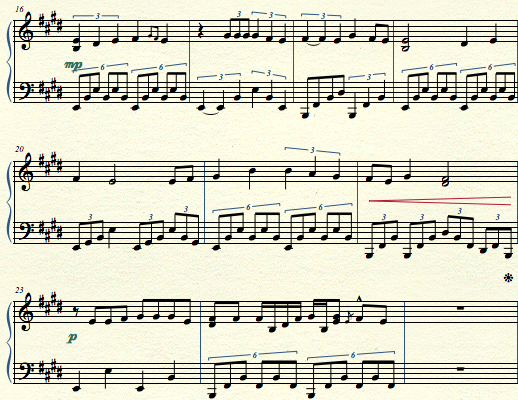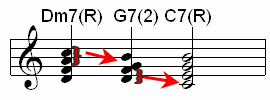The fake-outs I mentioned above are the three basic type of musical fake-outs.
I will go over all three in depth.
1. The Dynamic fake-out
A dynamic fake-out occurs when there in an increase in volume. The listener automatically thinks that there will be a sudden loudness. However, instead of going loud, the piece backs down to soft. For example, listen carefully to the end of this original piece by me:
https://soundcloud.com/menelik-david-kenneth-cannady/hunger
[spoiler=]Thought there was going to be a bang at the end right?[/spoiler]
Dynamic fake-outs are really effective, especially when you have a piece that has a lot of buildups.
Here's a visual of what a dynamic fake-out looks like:

Notice how in bar 16, the dynamic is at mezzo-piano, or medium soft. At measure 22, there's a crescendo. Immediately, one thinks it would go up to mezzo-forte (medium-loud) or forte (loud) or higher. But instead, it backs down to piano (soft).
In terms of electronic music, dynamic fake-outs are very effective when there have been small buildups. These buildups usually occur during a fill, which occurs after a 12 quarter-beat phrase. A phrase is usually 16 beats. The last 4 beats of a phrase are what make the buildup fill-in. After several of these, comes the dynamic fake-out, which is then followed by a very slow buildup.
The progression fake-out, as it's name entails, occurs when there is an abrupt shift in chord progression. Take the most common jazz chord progression out there: the ii-V-I or two five one.
This progression occurs at the last phrase of a blues progression.
Here's a visual:

In what is known as: a two five fake-out, the two chord and the five chord (the dominant) are played, but the one chord (the root), is not. Instead, the ii-V pattern is left unresolved and either another two five pattern is followed or, another chord other than the I is played.
Take this pattern from Charlie Parker's "Conformation"
F-E1/2dim-A7+9-Dm7G7Cm7F7Bb7
The chords in bold indicate the two five fake-outs.
The progression fake-out can also occur during transitions.
Take this progression:
F-C-Dm-Bb
A fake-out can be used to transition to another progression like this
F-C-Dm-G7
Notice there's a two five pattern here.
Progression fake-outs can lead to just about anything. Just make sure the chord fits appropriately and does not leave one thinking about "that one chord".
Last but not least
A key shift fake-out, or a modulation fake-out, occurs during a certain progression, where a key change could be taken.
Take this progression for instance.
C-D-G-Em-G-D-G
Clearly, this progression takes the key of C and modulates to G.
But, in some cases, this could be faked like this:
C-D-Gm-Bb...
This pattern could have also been made to fake out the G modulation and instead modulate to F like this:
C-D-Gm-C7-F
Look at this, it's the return of the two five one pattern.
But wait, there are many more ways to modulate. Still, since the fake-out is very versatile, it can adapt to other situations, like when the modulation is a half-step, like this:
F-Eb9-C#7-F#
This half-step modulation progression can also be faked, by switching the arrival chord (the one in bold shown above), to minor. This produces
F-Eb9-C#7-F#m-E7-A
Notice, that instead of modulating to F#, the fake-out to F# produced a modulation to A major.
In conclusion, if executed in the right manner, the fake-out can be a useful tool to sort of "throw off" your audience and make your music less predictable.
